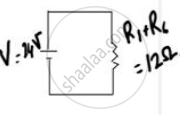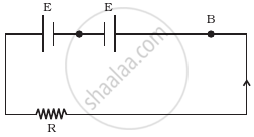Advertisements
Advertisements
प्रश्न

Calculate the total resistance of the circuit and find the total current in the circuit.
उत्तर


R3 and R4 are in series, hence the equivalent resistance of those two = R5 = R3 + R4 = 10 ohms
R5 and R2 are in parallel, Let R6 be the equivalent resistance for them. Hence R6 = (R5 × R2)/(R5 + R2) = 100/20 = 5 ohms
Now R1 and R6 are in series and hence the final equivalent resistance of the entire circuit is R = R1 + R6 = 12 ohms
By Ohm's Law we know that V = IR, hence I = V/R.
Hence the current in the circuit is 24/12 A = 2A
APPEARS IN
संबंधित प्रश्न
An electrical bulb is marked 200V, 100W. Calculate the electrical resistance of its filament. If five such
bulbs are connected in series to a 200V supply, how much current will flow through them?
- Draw a V-I graph for a conductor obeying Ohm’s law.
- What does the slope of V–I graph for a conductor represent?
Tick(✓) the correct choice in the following:
Ohm's law is applicable to
- Name and state the law which relates the potential difference and current in a conductor.
- What is the necessary condition for a conductor to obey the law named above in part (a) ?
Answer the following question.
Distinguish between Ohmic and non-ohmic substances; explain with the help of example.
Define Current density.
Explain the equivalent resistance of a parallel resistor network.
The temperature of a conductor is increased. The graph best showing the variation of its resistance is:
Two cells of same emf E but internal resistance r1 and r2 are connected in series to an external resistor R (Figure). What should be the value of R so that the potential difference across the terminals of the first cell becomes zero.
What is meant by resistance of a conductor ? Define its SI unit.
